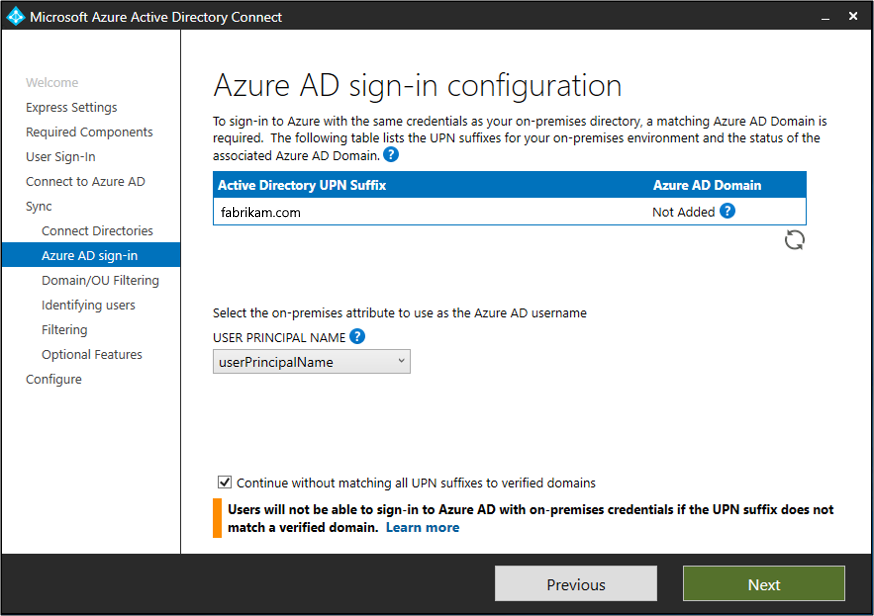Tous les articles par nutcracker
probleme syncro upn/alternative id sur compte azure ad
HARD Match upn
Set-MsolDirSyncFeature -Feature SynchronizeUpnForManagedUsers-Enable $True
SOFT match (alternative ID : SMTP…)
Set-MsolDirSyncFeature -Feature EnableSoftMatchOnUpn -Enable $True
Ne pas syncroniser le compte avant la creation SMTP sur exchange online et verifier activation soft match
Configuring Alternate Login ID
ou
How to use SMTP matching to match an on-premises user to a cloud identity
To use SMTP matching to match an on-premises user to an Office 365 user account for directory synchronization, follow these steps:
- Obtain the primary SMTP address of the target Office 365 user account. To do this, follow these steps:
- Sign in to the Office 365 portal as a global admin.
- Click Admin, and then click Exchange to open the Exchange admin center.
- In the Exchange admin center, locate and then double-click the user account that you want.
- Click email address, and then note the primary SMTP address of the user account.
- Start Active Directory Users and Computers, and then create a user account in the on-premises domain that matches the target Office 365 user account. For more information about how to do this, go to the following Microsoft TechNet website:
- Set the primary SMTP address of the new user account to match the primary SMTP address that you noted in step 1D.To do this by using Exchange Management tools, go to the following Microsoft websites:
If Exchange isn’t installed on-premises, you can manage the SMTP address value by using Active Directory Users and Computers:
- Right-click the user object, and then click Properties.
- On the general tab, update the E-mail field, and then click OK.
- Force directory synchronization. For more information about how to do this, go to the following Microsoft website:
SMTP matching limitations
The SMTP matching process has the following technical limitations:
- SMTP matching can be run on user accounts that have a Microsoft Exchange Online email address. For mail-enabled groups and contacts, SMTP matching (Soft match) is supported based on proxy addresses. For detailed information, refer to the « Hard-match vs Soft-match » section of the following Microsoft Azure article:Azure AD Connect: When you have an existent tenantNote This doesn’t mean the user must be licensed for Exchange Online. This means that a mailbox that has a primary email address must exist in Exchange Online for SMTP matching to work correctly.
- SMTP matching can be used only one time for user accounts that were originally authored by using Office 365 management tools. After that, the Office 365 user account is bound to the on-premises user by an immutable identity value instead of a primary SMTP address.
- The cloud user’s primary SMTP address can’t be updated during the SMTP matching process because the primary SMTP address is the value that is used to link the on-premises user to the cloud user.
- SMTP addresses are considered unique values. Make sure that no two users have the same SMTP address. Otherwise, the sync will fail and you may receive an error message that resembles the following
PS telecharger onedrive en pdf
Gestion groupe ADazure
cmdlet gestion des groupes
https://msdn.microsoft.com/en-us/library/321d532e-407d-4e29-a00a-8afbe23008dd#BKMK_ManageGroups
Integrer des utilisateurs au groupe
http://msoffice365exo.blogspot.com/p/add-members-to-security-group-through.html
restreindre l’envoi uniquement de mails en interne pour un groupe office365 /ajouter des infos courrier
type de groupes office365 dans GAL
powershell cacher les groupes 365 dans GAL
Set-UnifiedGroup<group>-HiddenFromAddressListsEnabled$true
|
1
|
Set |
If you want a group to accept messages from more than one group (multiple groups), you can give the group names as comma separated values in the above command.
|
1
|
Set-UnifiedGroup <group> -AcceptMessagesOnlyFromSendersOrMembers <group>,<group2> |
Set-DistributionGroup "Group Name" -HiddenFromAddressListsEnabled:$true
ou via AD
SOLUTION
To resolve this problem, follow these steps:
- Set the msExchHideFromAddressLists attribute of the security group to True. To do this, follow these steps:
- Open Active Directory Users and Computers.
- Locate and then right-click the group object, click Properties, and then click the Attribute Editor tab.
- Locate the msExchHideFromAddressLists attribute, click Edit, and then change the value from <Not set> to True.
- Wait for directory synchronization to occur. Or, force directory synchronization.
Desactivation de creation de groupes sur o365
desactiver la creation de groupe dans outlook, yammer,teams etc
http://www.eryem.com/2017/03/06/desactiver-la-creation-de-groupes-et-dequipes-dans-microsoft-teams/
Office 365 Groups vs Azure AD Security Groups
Office 365 Groups vs Azure AD Security Groups
probleme d’acces via groupe office365, recherche de site, hung workflow
https://threewill.com/office-365-groups-vs-azure-ad-security-groups/
mail enabled security group or not
https://www.imanami.com/mail-enable-an-active-directory-security-group-or-not/
best practise:
Do not add AD group directly to the site! Create a SharePoint group and add an AD group inside of a SharePoint group.
groupe de distribution dynamique
creer un groupe d utilisateurs destinataire selon des attributs personnalises
a tester
AD azure connect
outil de diagnostic integre

Using connectors with the Azure AD Connect Sync Service Manager
-visualiser les comptes utilisateurs syncronises
-modification du mot de passe du compte service ADDS (necessite redemarrage Synchronization Service)
update et Azure AD Connect
High CPU usage issue in Azure AD Connect Health for Sync
About Azure AD Connect Health agent
https://dirteam.com/sander/2018/06/18/knowledgebase-high-cpu-usage-for-azure-ad-connect-health-sync-monitor-with-net-framework-4-7-2-installed/
installation Azure AD Connect Health
voir les versions Azure AD Connect a upgrader US
https://docs.microsoft.com/en-us/azure/active-directory/connect/active-directory-aadconnect-version-history#118800
version french
https://docs.microsoft.com/fr-fr/azure/active-directory/connect/active-directory-aadconnect-version-history
version us 1.1.880.0
https://www.microsoft.com/en-us/download/details.aspx?id=47594
The following .NET framework update would cause the high CPU issue of monitoring agent:
|
.Net framework update |
OS version |
|
KB4338420 |
Windows Server 2008 |
|
KB4338606 |
Windows Server 2008 R2 |
|
KB4054542 |
Windows Server 2012 |
|
KB4054566 |
Windows Server 2012 R2 |
|
KB4054590 KB4338814 KB4338419 KB4338605 KB4345418 |
General |
